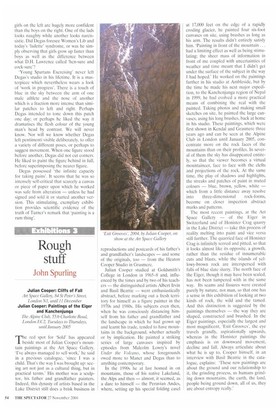Rough stuff
John Spurling
Julian Cooper: Cliffs of Fail Art Space Gallery, 84 St Peter's Street, London NI, until II December Julian Cooper: Paintings of the Eiger and Kanchenjunqa The Alpine Club, 55/6 Charlotte Road, London EC2, Tuesdays to Thursdays, until January 2005
The red spot for 'Sold' has appeared beside most of Julian Cooper's mountain paintings at the Art Space Gallery. 'I've always managed to sell work,' he said in a previous catalogue, 'since I was a child. That's the way I was brought up: seeing art not just as a cultural thing, but in practical terms.' His mother was a sculptor, his father and grandfather painters. Indeed, this dynasty of artists based in the Lake District still does a brisk business in
reproductions and postcards of his father's and grandfather's landscapes — and some of the originals, too — from the Heaton Cooper Studio in Grasmere.
Julian Cooper studied at Goldsmith's College in London in 1965-8 and, influenced by the times and by two of his teachers — the distinguished artists Albert Irvin and Basil Beattie — went enthusiastically abstract, before marking out a fresh territory for himself as a figure painter in the 1970s and 1980s. His subjects even then, when he was consciously distancing himself from his father and grandfather and the landscape in which he had grown up and learnt his trade, tended to have mountains in the background, whether actually or by implication. He painted a striking series of large canvases inspired by episodes from Malcolm Lowry's novel Under the Volcano, whose foregrounds owed more to Manet and Degas than to anything contemporary.
In the 1990s he at last homed in on mountains, those of his native Lakeland, the Alps and then — almost, it seemed, as a dare to himself — the Peruvian Andes, where, setting up his special folding easel at 17,000 feet on the edge of a rapidly eroding glacier, he painted four six-foot canvases on site, using brushes as long as his arm. The results didn't entirely satisfy him. 'Painting in front of the mountain ... had a limiting effect as well as being stimulating; the sheer mass of information in front of me coupled with uncertainties of weather and time meant that I didn't get under the surface of the subject in the way I had hoped.' He worked on the paintings further in his studio at Arnbleside, but by the time he made his next major expedition, to the Kanchenjunga region of Nepal in 1999, he had evolved a more practical means of combining the real with the painted. Taking photos and making small sketches on site, he painted the large canvases, using his long brushes, back at home in his studio. These paintings, which were first shown in Kendal and Grasmere three years ago and can be seen at the Alpine Club in London until January 2005, concentrate more on the rock faces of the mountains than on their profiles. In several of them the sky has disappeared entirely, so that the viewer becomes a virtual mountaineer, face to face with the clefts and projections of the rock. At the same time, the play of shadows and highlights, the streaks and patches of paint in muted colours — blue, brown, yellow, white — which from a little distance away resolve
into three-dimensional rock-forms, become on closer inspection abstract marks and patterns.
The most recent paintings, at the Art Space Gallery — of the Eiger in Switzerland and of Honister Crag quarry in the Lake District — take this process of reality melting into paint and vice versa still further. The quarried face of Honister Crag is infinitely scored and pitted, so that it looks almost like its opposite, a growth, rather than the residue of innumerable cuts and blasts, while the islands of yellowy-brown rock are interspersed with falls of blue slate slurry. The north face of the Eiger, though it may have been scaled, has not been tampered with in the same way. Its seams and fissures were created purely by nature, not man, so that one has a sense in this exhibition of looking at two kinds of rock, the wild and the tamed. And this distinction is suggested by the paintings themselves — the way they are shaped, constructed and brushed. In the Eiger paintings, especially the largest and most magnificent, 'Exit Grooves', the eye travels grandly, aspirationally upwards, whereas in the Honister paintings the emphasis is on downward movement, decline and fall. Always articulate about what he is up to, Cooper himself, in an interview with Basil Beattie in the catalogue, explains: "These new paintings are about the ground and our relationship to it, the grinding process, us humans grinding down mountains, the earth, the land, people being ground down, all of us, they are about entropy really.'


















































































 Previous page
Previous page